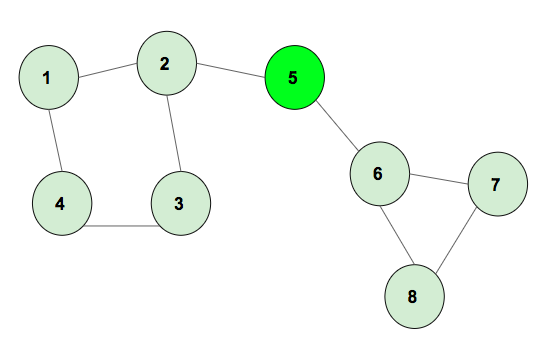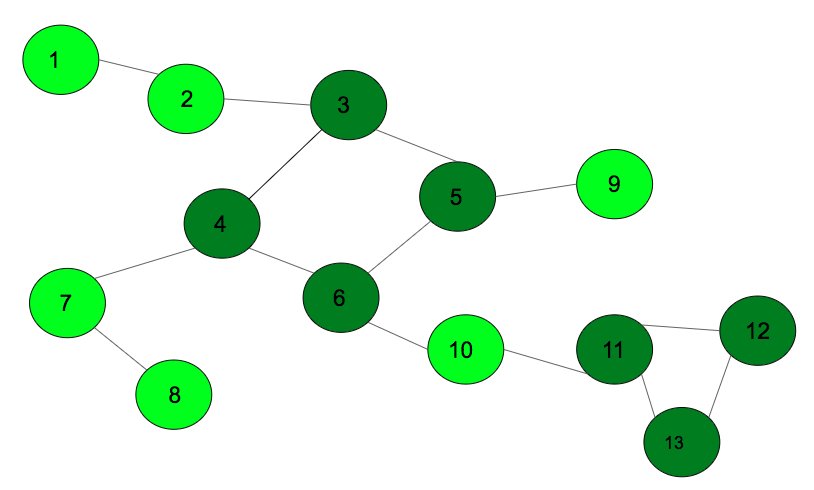无向图中所有循环长度的乘积
给定一个无向且未加权的图。任务是找到其中形成的所有循环的长度的乘积。
示例 1:

The above graph has two cycles of length 4 and 3, the product of cycle lengths is 12.
示例 2:

The above graph has two cycles of length 4 and 3, the product of cycle lengths is 12.
方法:使用图形着色方法,用唯一的数字标记不同循环的所有顶点。一旦图遍历完成,将所有相似的标记数字推送到邻接表并相应地打印邻接表。下面给出算法:
- 将边缘插入邻接列表。
- 调用使用着色方法标记顶点的 DFS函数。
- 每当有一个部分访问的顶点时,回溯直到到达当前顶点并用循环数标记所有顶点。标记完所有顶点后,增加循环数。
- 一旦 Dfs 完成,迭代边缘并将相同的标记数字边缘推送到另一个邻接列表。
- 在另一个邻接列表中迭代,并使用映射和循环数保持循环中顶点数的计数
- 迭代循环数,并乘以长度以获得最终结果,这将是答案。
下面是上述方法的实现:
C++
// C++ program to find the
// product of lengths of cycle
#include
using namespace std;
const int N = 100000;
// variables to be used
// in both functions
vector graph[N];
// Function to mark the vertex with
// different colors for different cycles
void dfs_cycle(int u, int p, int color[],
int mark[], int par[], int& cyclenumber)
{
// already (completely) visited vertex.
if (color[u] == 2) {
return;
}
// seen vertex, but was not completely
// visited -> cycle detected.
// backtrack based on parents to find
// the complete cycle.
if (color[u] == 1) {
cyclenumber++;
int cur = p;
mark[cur] = cyclenumber;
// backtrack the vertex which are
// in the current cycle thats found
while (cur != u) {
cur = par[cur];
mark[cur] = cyclenumber;
}
return;
}
par[u] = p;
// partially visited.
color[u] = 1;
// simple dfs on graph
for (int v : graph[u]) {
// if it has not been visited previously
if (v == par[u]) {
continue;
}
dfs_cycle(v, u, color, mark, par, cyclenumber);
}
// completely visited.
color[u] = 2;
}
// add the edges to the graph
void addEdge(int u, int v)
{
graph[u].push_back(v);
graph[v].push_back(u);
}
// Function to print the cycles
int productLength(int edges, int mark[], int& cyclenumber)
{
unordered_map mp;
// push the edges that into the
// cycle adjacency list
for (int i = 1; i <= edges; i++) {
if (mark[i] != 0)
mp[mark[i]]++;
}
int cnt = 1;
// product all the length of cycles
for (int i = 1; i <= cyclenumber; i++) {
cnt = cnt * mp[i];
}
if (cyclenumber == 0)
cnt = 0;
return cnt;
}
// Driver Code
int main()
{
// add edges
addEdge(1, 2);
addEdge(2, 3);
addEdge(3, 4);
addEdge(4, 6);
addEdge(4, 7);
addEdge(5, 6);
addEdge(3, 5);
addEdge(7, 8);
addEdge(6, 10);
addEdge(5, 9);
addEdge(10, 11);
addEdge(11, 12);
addEdge(11, 13);
addEdge(12, 13);
// arrays required to color the
// graph, store the parent of node
int color[N];
int par[N];
// mark with unique numbers
int mark[N];
// store the numbers of cycle
int cyclenumber = 0;
int edges = 13;
// call DFS to mark the cycles
dfs_cycle(1, 0, color, mark, par, cyclenumber);
// function to print the cycles
cout << productLength(edges, mark, cyclenumber);
return 0;
} Java
// Java program to find the
// product of lengths of cycle
import java.io.*;
import java.util.*;
class GFG
{
static int N = 100000;
static int cyclenumber;
// variables to be used
// in both functions
//@SuppressWarnings("unchecked")
static Vector[] graph = new Vector[N];
// This static block is used to initialize
// array of Vector, otherwise it will throw
// NullPointerException
static
{
for (int i = 0; i < N; i++)
graph[i] = new Vector<>();
}
// Function to mark the vertex with
// different colors for different cycles
static void dfs_cycle(int u, int p, int[] color,
int[] mark, int[] par)
{
// already (completely) visited vertex.
if (color[u] == 2)
return;
// seen vertex, but was not completely
// visited -> cycle detected.
// backtrack based on parents to find
// the complete cycle.
if (color[u] == 1)
{
cyclenumber++;
int cur = p;
mark[cur] = cyclenumber;
// backtrack the vertex which are
// in the current cycle thats found
while (cur != u)
{
cur = par[cur];
mark[cur] = cyclenumber;
}
return;
}
par[u] = p;
// partially visited.
color[u] = 1;
// simple dfs on graph
for (int v : graph[u])
{
// if it has not been visited previously
if (v == par[u])
{
continue;
}
dfs_cycle(v, u, color, mark, par);
}
// completely visited.
color[u] = 2;
}
// add the edges to the graph
static void addEdge(int u, int v)
{
graph[u].add(v);
graph[v].add(u);
}
// Function to print the cycles
static int productLength(int edges, int[] mark)
{
HashMap mp = new HashMap<>();
// push the edges that into the
// cycle adjacency list
for (int i = 1; i <= edges; i++)
{
if (mark[i] != 0)
{
mp.put(mark[i], mp.get(mark[i]) == null ?
1 : mp.get(mark[i]) + 1);
}
}
int cnt = 1;
// product all the length of cycles
for (int i = 1; i <= cyclenumber; i++)
{
cnt = cnt * mp.get(i);
}
if (cyclenumber == 0)
cnt = 0;
return cnt;
}
// Driver Code
public static void main(String[] args) throws IOException
{
// add edges
addEdge(1, 2);
addEdge(2, 3);
addEdge(3, 4);
addEdge(4, 6);
addEdge(4, 7);
addEdge(5, 6);
addEdge(3, 5);
addEdge(7, 8);
addEdge(6, 10);
addEdge(5, 9);
addEdge(10, 11);
addEdge(11, 12);
addEdge(11, 13);
addEdge(12, 13);
// arrays required to color the
// graph, store the parent of node
int[] color = new int[N];
int[] par = new int[N];
// mark with unique numbers
int[] mark = new int[N];
// store the numbers of cycle
cyclenumber = 0;
int edges = 13;
// call DFS to mark the cycles
dfs_cycle(1, 0, color, mark, par);
// function to print the cycles
System.out.println(productLength(edges, mark));
}
}
// This code is contributed by
// sanjeev2552 Python3
# Python3 program to find the
# product of lengths of cycle
from collections import defaultdict
# Function to mark the vertex with
# different colors for different cycles
def dfs_cycle(u, p, color, mark, par):
global cyclenumber
# already (completely) visited vertex.
if color[u] == 2:
return
# seen vertex, but was not completely
# visited -> cycle detected.
# backtrack based on parents to find
# the complete cycle.
if color[u] == 1:
cyclenumber += 1
cur = p
mark[cur] = cyclenumber
# backtrack the vertex which are
# in the current cycle thats found
while cur != u:
cur = par[cur]
mark[cur] = cyclenumber
return
par[u] = p
# partially visited.
color[u] = 1
# simple dfs on graph
for v in graph[u]:
# if it has not been visited previously
if v == par[u]:
continue
dfs_cycle(v, u, color, mark, par)
# completely visited.
color[u] = 2
# add the edges to the graph
def addEdge(u, v):
graph[u].append(v)
graph[v].append(u)
# Function to print the cycles
def productLength(edges, mark, cyclenumber):
mp = defaultdict(lambda:0)
# push the edges that into the
# cycle adjacency list
for i in range(1, edges+1):
if mark[i] != 0:
mp[mark[i]] += 1
cnt = 1
# product all the length of cycles
for i in range(1, cyclenumber + 1):
cnt = cnt * mp[i]
if cyclenumber == 0:
cnt = 0
return cnt
# Driver Code
if __name__ == "__main__":
N = 100000
graph = [[] for i in range(N)]
# add edges
addEdge(1, 2)
addEdge(2, 3)
addEdge(3, 4)
addEdge(4, 6)
addEdge(4, 7)
addEdge(5, 6)
addEdge(3, 5)
addEdge(7, 8)
addEdge(6, 10)
addEdge(5, 9)
addEdge(10, 11)
addEdge(11, 12)
addEdge(11, 13)
addEdge(12, 13)
# arrays required to color the
# graph, store the parent of node
color, par = [None] * N, [None] * N
# mark with unique numbers
mark = [None] * N
# store the numbers of cycle
cyclenumber, edges = 0, 13
# call DFS to mark the cycles
dfs_cycle(1, 0, color, mark, par)
# function to print the cycles
print(productLength(edges, mark,
cyclenumber))
# This code is contributed by Rituraj JainC#
// C# program to find the
// product of lengths of cycle
using System;
using System.Collections.Generic;
class GFG
{
static int N = 100000;
static int cyclenumber;
// variables to be used
// in both functions
//@SuppressWarnings("unchecked")
static List[] graph = new List[N];
// This static block is used to initialize
// array of List, otherwise it will throw
// NullPointerException
// Function to mark the vertex with
// different colors for different cycles
static void dfs_cycle(int u, int p, int[] color,
int[] mark, int[] par)
{
// already (completely) visited vertex.
if (color[u] == 2)
return;
// seen vertex, but was not completely
// visited -> cycle detected.
// backtrack based on parents to find
// the complete cycle.
if (color[u] == 1)
{
cyclenumber++;
int cur = p;
mark[cur] = cyclenumber;
// backtrack the vertex which are
// in the current cycle thats found
while (cur != u)
{
cur = par[cur];
mark[cur] = cyclenumber;
}
return;
}
par[u] = p;
// partially visited.
color[u] = 1;
// simple dfs on graph
foreach (int v in graph[u])
{
// if it has not been visited previously
if (v == par[u])
{
continue;
}
dfs_cycle(v, u, color, mark, par);
}
// completely visited.
color[u] = 2;
}
// add the edges to the graph
static void addEdge(int u, int v)
{
graph[u].Add(v);
graph[v].Add(u);
}
// Function to print the cycles
static int productLength(int edges, int[] mark)
{
Dictionary mp = new Dictionary();
// push the edges that into the
// cycle adjacency list
for (int i = 1; i <= edges; i++)
{
if (mark[i] != 0)
{
if(mp.ContainsKey(mark[i]))
mp[mark[i]] = mp[mark[i]] + 1;
else
mp.Add(mark[i], 1);
}
}
int cnt = 1;
// product all the length of cycles
for (int i = 1; i <= cyclenumber; i++)
{
cnt = cnt * mp[i];
}
if (cyclenumber == 0)
cnt = 0;
return cnt;
}
// Driver Code
public static void Main(String[] args)
{
for (int i = 0; i < N; i++)
graph[i] = new List();
// add edges
addEdge(1, 2);
addEdge(2, 3);
addEdge(3, 4);
addEdge(4, 6);
addEdge(4, 7);
addEdge(5, 6);
addEdge(3, 5);
addEdge(7, 8);
addEdge(6, 10);
addEdge(5, 9);
addEdge(10, 11);
addEdge(11, 12);
addEdge(11, 13);
addEdge(12, 13);
// arrays required to color the
// graph, store the parent of node
int[] color = new int[N];
int[] par = new int[N];
// mark with unique numbers
int[] mark = new int[N];
// store the numbers of cycle
cyclenumber = 0;
int edges = 13;
// call DFS to mark the cycles
dfs_cycle(1, 0, color, mark, par);
// function to print the cycles
Console.WriteLine(productLength(edges, mark));
}
}
// This code is contributed by 29AjayKumar Javascript
输出:
12时间复杂度:O(N),其中 N 是图中的节点数。